The Classification and Evaluation of an Interlayer Shale Oil Reservoir Based on the Fractal Characteristics of Pore Systems: A Case Study in the HSN Area, China
Abstract
1. Introduction
2. Materials and Methods
2.1. Geological Setting
2.2. Methodology
3. Results
3.1. Porosity and Permeability of Shale Samples in Chang 7
3.2. Pore Types of Shale Samples in Chang 7
3.3. Pore Network of Shale Samples in Chang 7
3.4. Overall Pore Size Distribution of Shale Samples in Chang 7
4. Discussion
4.1. Fractal Dimensions Calculated from HMIP
4.2. Classification of Pore Systems Based on Fractal Pore System
4.3. Shale Reservoir Classification Based on Pore System Classification
5. Conclusions
- (1)
- Four main types of pores are identified in shale samples from Chang 7 in the HSN area. These include residual intergranular pores, dissolution pores, intercrystalline pores of clay minerals and microfractures. The overall pore size distribution of shale samples predominantly falls within the range of 3 nm to 50 μm.
- (2)
- In the Chang 7 interlayer shale in the HSN area, the pore system exhibits multiple fractal characteristics. A scatter plot with three inflection points divides the pore system into four regions, each corresponding to specific pore radii. Based on this, a classification of pores is conducted, distinguishing them into macropores, mesopores, micropores and ultramicropores. Using the proportions of these different pores within the samples, the samples are categorized into four classes. Standards for porosity and permeability are established for these four reservoir classes.
- (3)
- Based on the established standards for porosity and permeability in reservoir classification, the planar distribution of different reservoir types becomes clearly defined. There is a notable difference in the daily oil production from wells across different types of reservoirs. Class I reservoirs exhibit higher daily oil production as the reservoir thickness increases.
Author Contributions
Funding
Data Availability Statement
Conflicts of Interest
References
- Taheri-Shakib, J.; Kantzas, A. A comprehensive review of microwave application on the oil shale: Prospects for shale oil production. Fuel 2021, 305, 121519. [Google Scholar] [CrossRef]
- Feng, Q.; Xu, S.; Xing, X.; Zhang, W.; Wang, S. Advances and challenges in shale oil development: A critical review. Adv. Geo-Energy Res. 2020, 4, 406–418. [Google Scholar] [CrossRef]
- Zhang, L.; He, X.; Li, X.; Li, K.; He, J.; Zhang, Z.; Guo, J.; Chen, Y.; Liu, W. Shale gas exploration and development in the Sichuan Basin: Progress, challenge and countermeasures. Nat. Gas Ind. B 2022, 9, 176–186. [Google Scholar] [CrossRef]
- Fakher, S.; Imqam, A. Application of carbon dioxide injection in shale oil reservoirs for increasing oil recovery and carbon dioxide storage. Fuel 2020, 265, 116944. [Google Scholar] [CrossRef]
- Jin, Z.; Zhu, R.; Liang, X.; Shen, Y. Several issues worthy of attention in current lacustrine shale oil exploration and development. Pet. Explor. Dev. 2021, 48, 1471–1484. [Google Scholar] [CrossRef]
- Wang, F.; Fu, Z.; Wang, J.; Tang, Z.G.; Jiang, R.G. Characteristics and classification evaluation of Gulong shale oil reservoir in Songliao Basin. Pet. Geol. Oilfield Dev. Daqing 2021, 40, 144–156. [Google Scholar]
- Lei, H.; Guo, P.; Meng, Y.; Qi, J.; Liu, J.; Zhang, J.; Liu, M.; Zheng, Y. Pore structure and classification evaluation of shale oil reservoirs of Permian Fengcheng Formation in Mahu Sag. Lithol. Reserv. 2022, 34, 142–153. [Google Scholar]
- Zou, Y.; Wei, P.; Cao, Y.; Wang, J.; Zhao, X.; He, W.; Zhao, Y.; Jiang, Y.; Sun, S. Classification and main controlling factors of sweet spots of alkaline lake type shale oil: A case study of Fengcheng Formation in Junggar Basin. Acta Pet. Sin. 2023, 44, 458–470. [Google Scholar]
- Huang, W.; Lu, S.; Hersi, O.S.; Wang, M.; Deng, S.; Lu, R. Reservoir spaces in tight sandstones: Classification, fractal characters, and heterogeneity. J. Nat. Gas Sci. Eng. 2017, 46, 80–92. [Google Scholar] [CrossRef]
- Gao, H.; Zhou, X.; Wen, Z.; Guo, W.; Tian, W.; Li, S.; Fan, Y.; Luo, Y. Classification and Evaluation of Shale Oil Reservoirs of the Chang 71-2 Sub-Member in the Longdong Area. Energies 2022, 15, 5364. [Google Scholar] [CrossRef]
- Song, W.; Wang, D.; Yao, J.; Li, Y.; Sun, H.; Yang, Y.; Zhang, L. Multiscale image-based fractal characteristic of shale pore structure with implication to accurate prediction of gas permeability. Fuel 2019, 241, 522–532. [Google Scholar] [CrossRef]
- Liu, K.; Ostadhassan, M.; Kong, L. Fractal and multifractal characteristics of pore throats in the Bakken Shale. Transp. Porous Media 2019, 126, 579–598. [Google Scholar] [CrossRef]
- Wang, L.; Lv, D.; Hower, J.C.; Zhang, Z.; Raji, M.; Tang, J.; Liu, Y.; Gao, J. Geochemical characteristics and paleoclimate implication of Middle Jurassic coal in the Ordos Basin, China. Ore Geol. Rev. 2022, 144, 104848. [Google Scholar] [CrossRef]
- Hou, L.; Pang, Z.; Luo, X.; Lin, S. Sedimentary features of the gravity flow influenced shale deposit: A case study of Chang 7 member in the Ordos Basin, China. Mar. Pet. Geol. 2023, 153, 106277. [Google Scholar] [CrossRef]
- Chen, G.; Gang, W.; Chang, X.; Wang, N.; Zhang, P.; Cao, Q.; Xu, J. Paleoproductivity of the Chang 7 unit in the Ordos Basin (North China) and its controlling factors. Palaeogeogr. Palaeoclimatol. Palaeoecol. 2020, 551, 109741. [Google Scholar]
- Pan, S.; Liao, Y.; Jiang, B. Impact of natural weathering on source rocks: ESI FT-ICR MS evidence from Triassic Chang 7 outcrop profile in Tongchuan City, Southern Ordos Basin (China). Mar. Pet. Geol. 2023, 155, 106410. [Google Scholar] [CrossRef]
- Wang, X.; Hou, J.; Song, S.; Wang, D.; Gong, L.; Ma, K.; Liu, Y.; Li, Y.; Yan, L. Combining pressure-controlled porosimetry and rate-controlled porosimetry to investigate the fractal characteristics of full-range pores in tight oil reservoirs. J. Pet. Sci. Eng. 2018, 171, 353–361. [Google Scholar] [CrossRef]
- House, A.; Dennis, M.; Warlow, C.; Hawton, K.; Molyneux, A. Mood disorders after stroke and their relation to lesion location. CT scan study. Brain 1990, 113, 1113–1129. [Google Scholar] [CrossRef]
- Zhang, P.; Lu, S.; Li, J.; Chang, X. 1D and 2D Nuclear magnetic resonance (NMR) relaxation behaviors of protons in clay, kerogen and oil-bearing shale rocks. Mar. Pet. Geol. 2020, 114, 104210. [Google Scholar] [CrossRef]
- Liu, T.; Cui, M.; Zhang, C.; Zhou, K.; Shi, W.; Cao, P. Nuclear magnetic resonance analysis of the failure and damage model of rock masses during freeze–thaw cycles. Bull. Eng. Geol. Environ. 2022, 81, 445. [Google Scholar] [CrossRef]
- Nimmo, J.R. Porosity and pore size distribution. Encycl. Soils Environ. 2004, 3, 295–303. [Google Scholar]
- Wang, X.; Hou, J.; Li, S.; Dou, L.; Song, S.; Kang, Q.; Wang, D. Insight into the nanoscale pore structure of organic-rich shales in the Bakken Formation, USA. J. Pet. Sci. Eng. 2020, 191, 107182. [Google Scholar] [CrossRef]
- Nasseri, M.H.B.; Rezanezhad, F.; Young, R.P. Analysis of fracture damage zone in anisotropic granitic rock using 3D X-ray CT scanning techniques. Int. J. Fract. 2011, 168, 1–13. [Google Scholar] [CrossRef]
- Zhao, H.; Ning, Z.; Wang, Q.; Zhang, R.; Zhao, T.; Niu, T.; Zeng, Y. Petrophysical characterization of tight oil reservoirs using pressure-controlled porosimetry combined with rate-controlled porosimetry. Fuel 2015, 154, 233–242. [Google Scholar] [CrossRef]
- Mandelbrot, B. Objects Fractals: Forme, Hasard et Dimension; Flammarion: Paris, France, 1975. [Google Scholar]
- Wang, X.; Hou, J.; Liu, Y.; Zhao, P.; Ma, K.; Wang, D.; Ren, X.; Yan, L. Overall PSD and fractal characteristics of tight oil reservoirs: A case study of Lucaogou Formation in Junggar Basin, China. Fractals 2019, 27, 1940005. [Google Scholar] [CrossRef]
- Liu, D.; Gu, Z.; Liang, R.; Su, J.; Ren, D.; Chen, B.; Huang, C.; Yang, C. Impacts of pore-throat system on fractal characterization of tight sandstones. Geofluids 2020, 2020, 4941501. [Google Scholar] [CrossRef]
- Qu, Y.; Sun, W.; Tao, R.; Luo, B.; Chen, L.; Ren, D. Pore–throat structure and fractal characteristics of tight sandstones in Yanchang Formation, Ordos Basin. Mar. Pet. Geol. 2020, 120, 104573. [Google Scholar] [CrossRef]
- Cao, Y.; Zhu, N.; Zhang, S.; Xi, K.L.; Xue, X.J. Diagenesis and reserving space characteristics of tight oil reservoirs of Permian Lucaogou Formation in Jimusar Sag of Junggar Basin, China. J. Earth Sci. Environ. 2019, 41, 253–266. [Google Scholar]



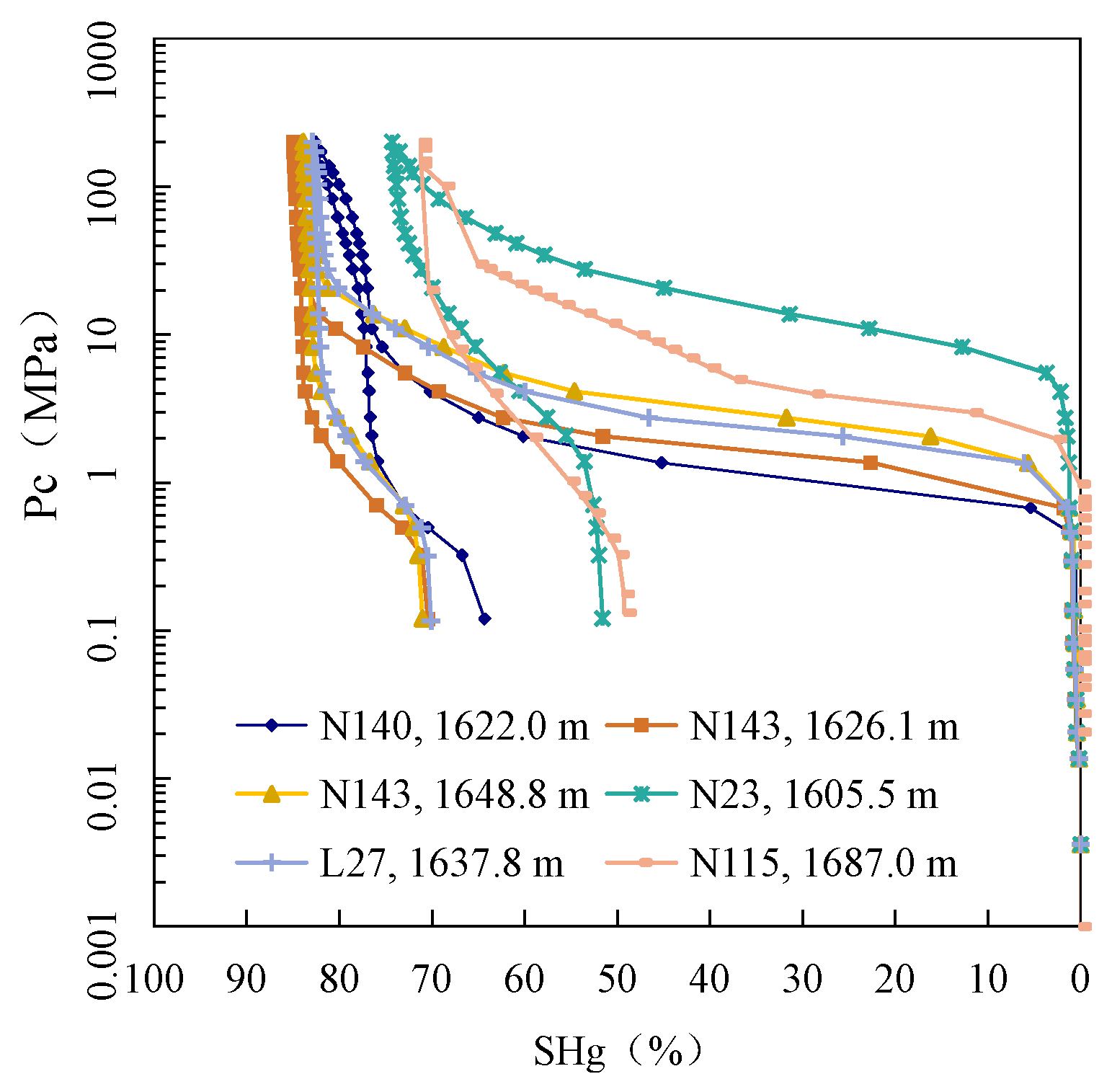
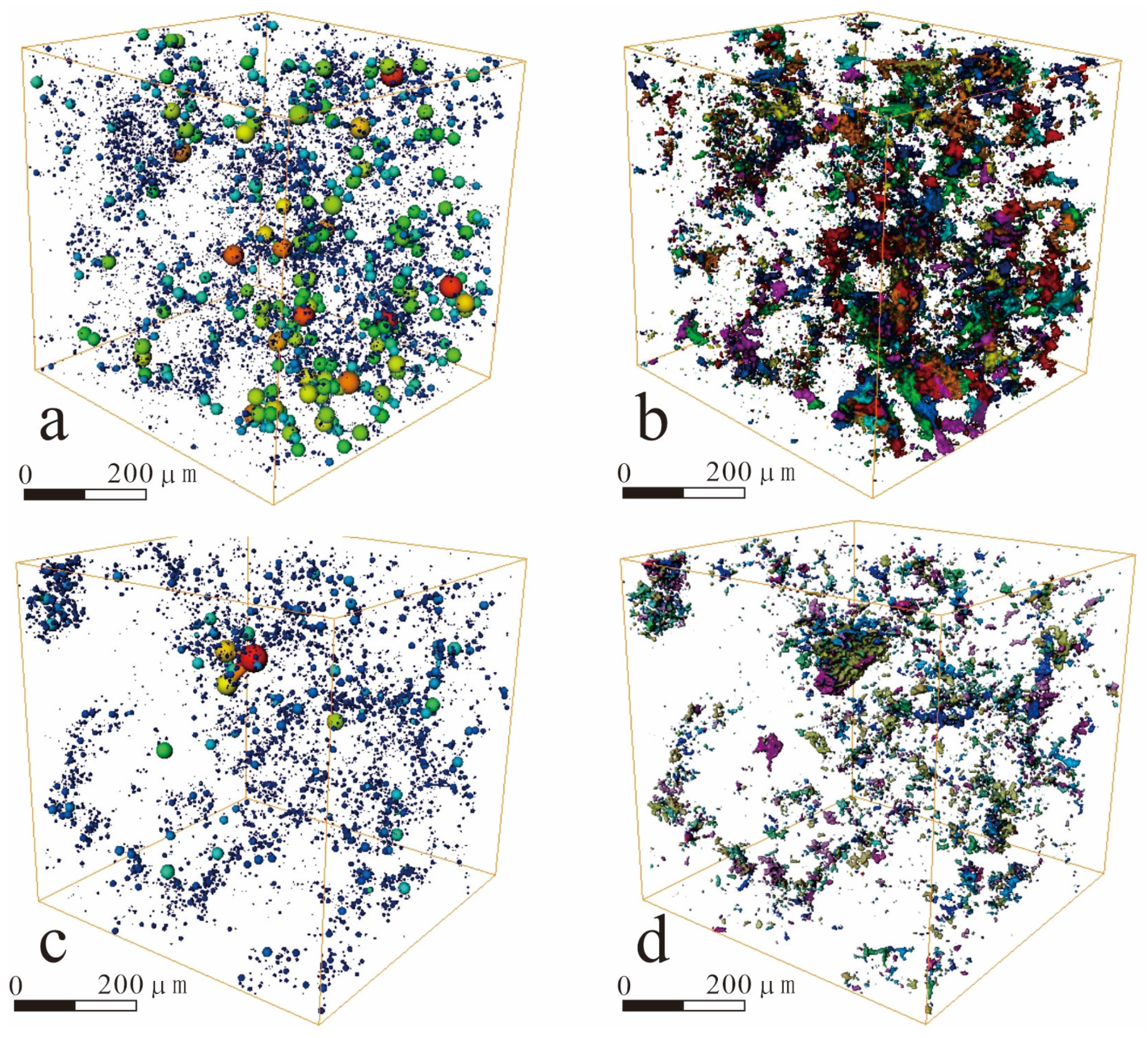

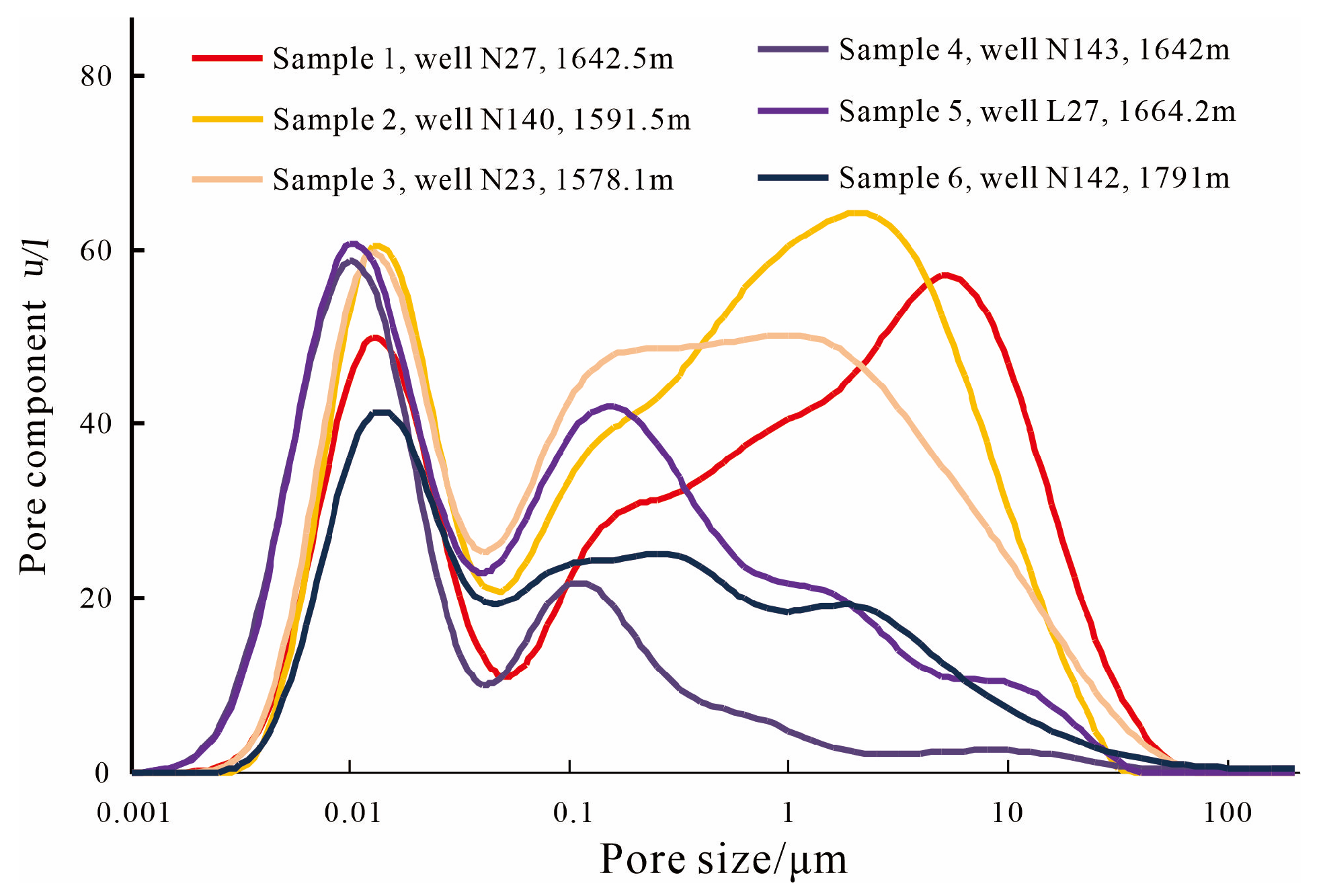
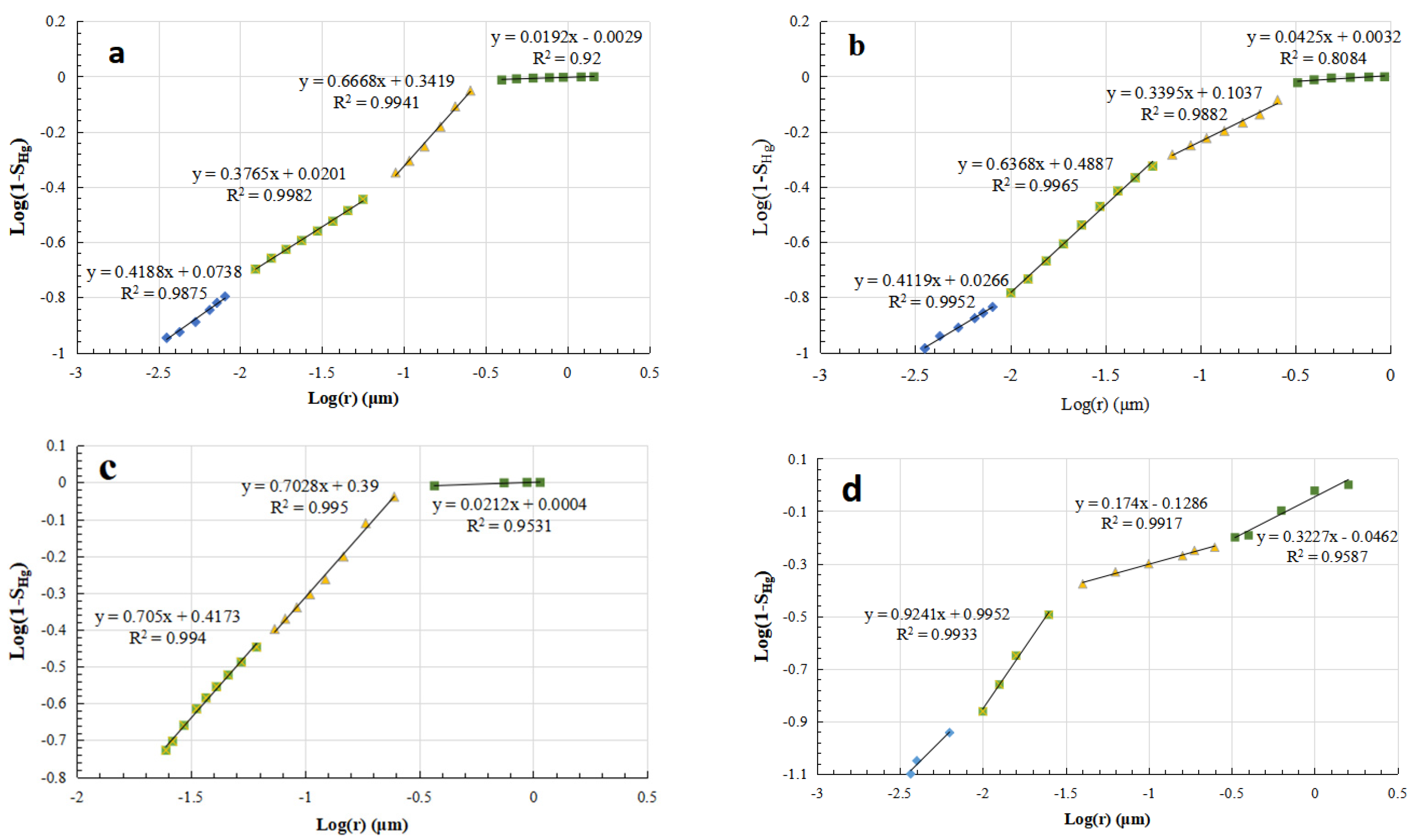


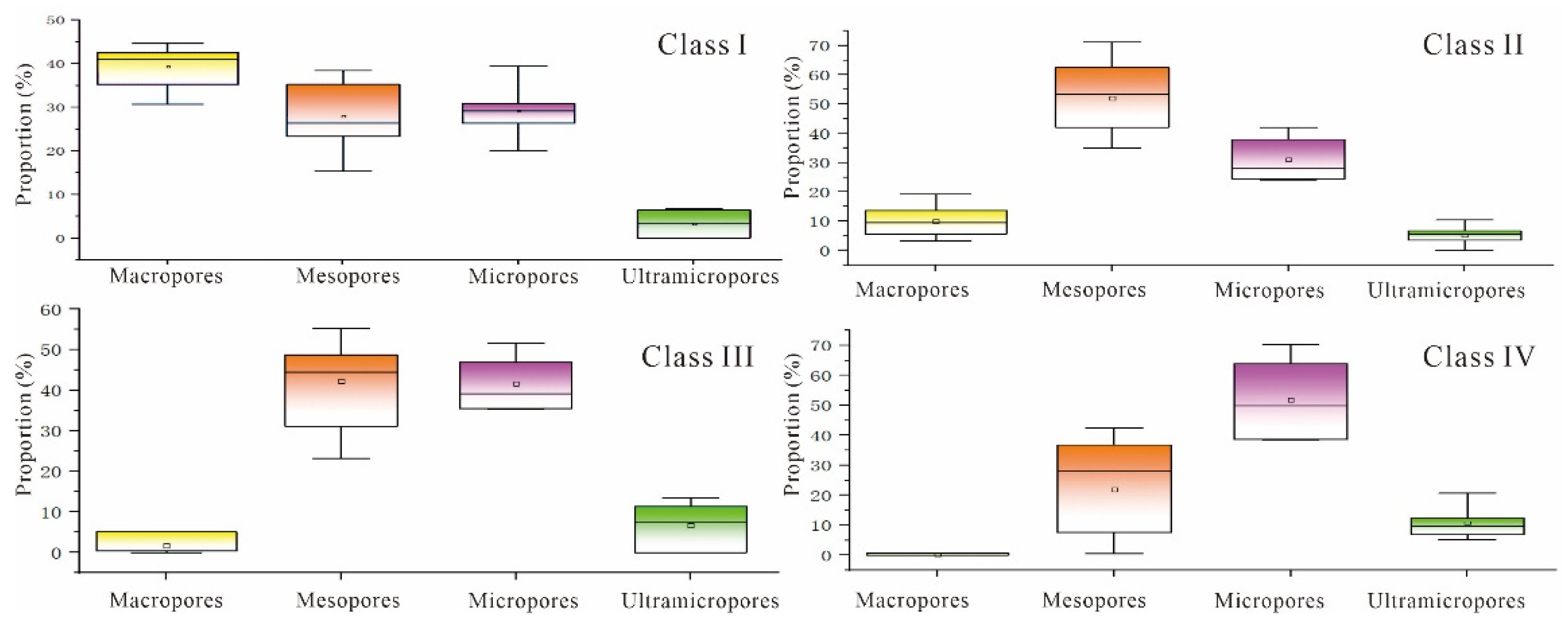

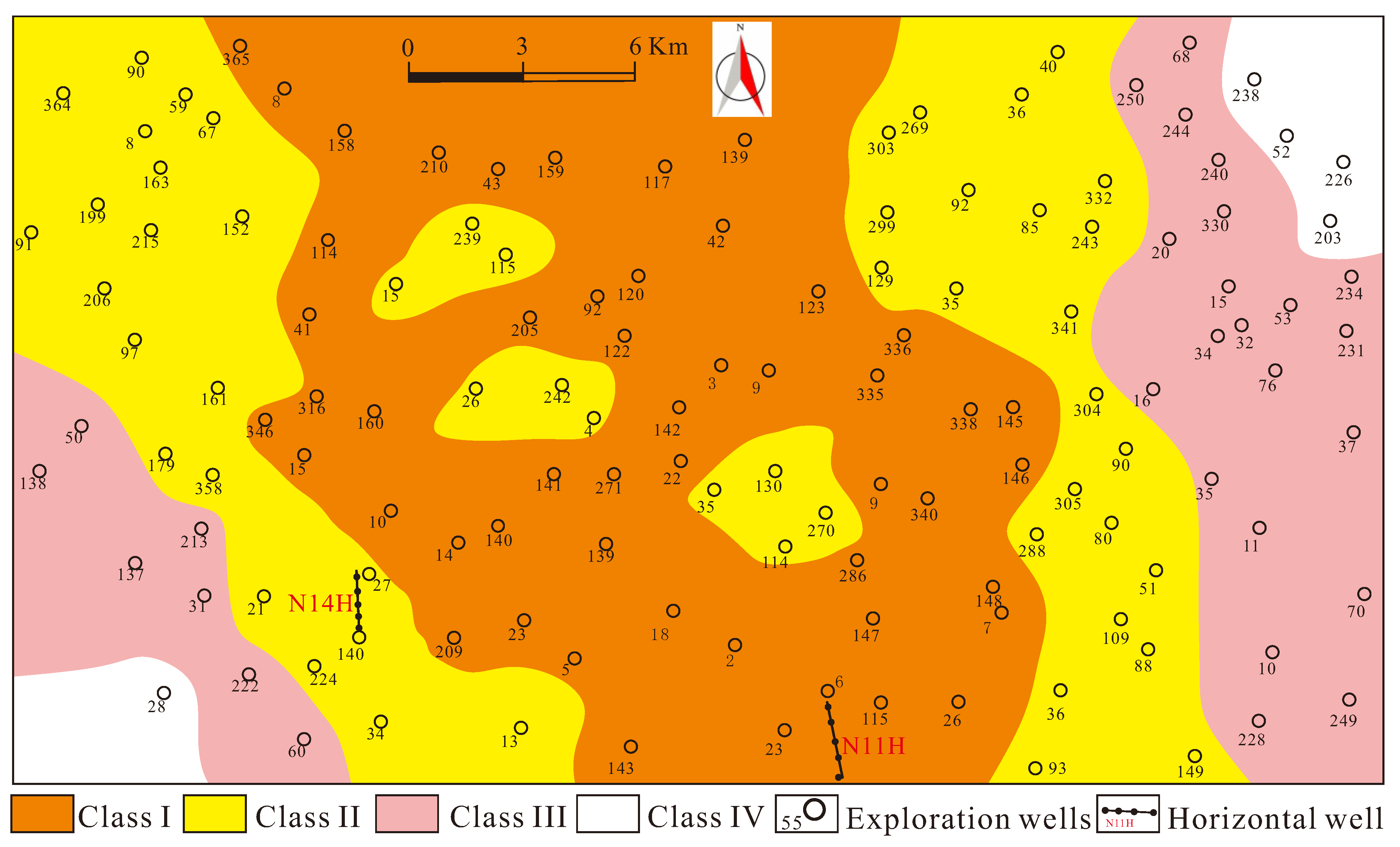

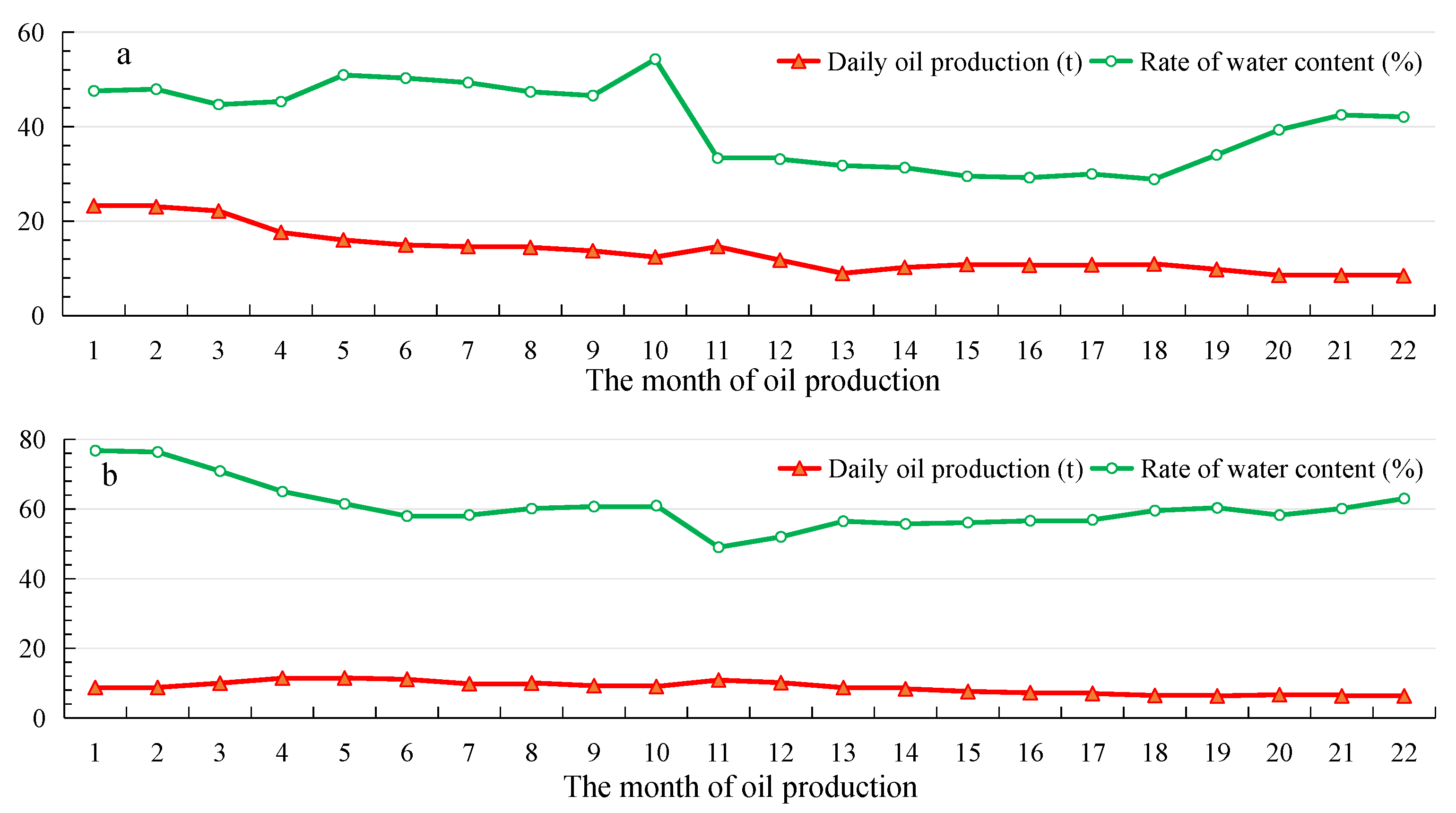
| Pore Systems | Macropore | Mesopore | Micropore | Ultramicropore |
|---|---|---|---|---|
| Pore radius (μm) | >0.2 | 0.2–0.08 | 0.08–0.03 | <0.03 |
Disclaimer/Publisher’s Note: The statements, opinions and data contained in all publications are solely those of the individual author(s) and contributor(s) and not of MDPI and/or the editor(s). MDPI and/or the editor(s) disclaim responsibility for any injury to people or property resulting from any ideas, methods, instructions or products referred to in the content. |
© 2024 by the authors. Licensee MDPI, Basel, Switzerland. This article is an open access article distributed under the terms and conditions of the Creative Commons Attribution (CC BY) license (https://creativecommons.org/licenses/by/4.0/).
Share and Cite
Lu, C.; Wang, X.; Ma, S.; Li, S.; Xue, T.; Li, Q. The Classification and Evaluation of an Interlayer Shale Oil Reservoir Based on the Fractal Characteristics of Pore Systems: A Case Study in the HSN Area, China. Fractal Fract. 2024, 8, 167. https://doi.org/10.3390/fractalfract8030167
Lu C, Wang X, Ma S, Li S, Xue T, Li Q. The Classification and Evaluation of an Interlayer Shale Oil Reservoir Based on the Fractal Characteristics of Pore Systems: A Case Study in the HSN Area, China. Fractal and Fractional. 2024; 8(3):167. https://doi.org/10.3390/fractalfract8030167
Chicago/Turabian StyleLu, Changsheng, Xixin Wang, Shuwei Ma, Shaohua Li, Ting Xue, and Qiangqiang Li. 2024. "The Classification and Evaluation of an Interlayer Shale Oil Reservoir Based on the Fractal Characteristics of Pore Systems: A Case Study in the HSN Area, China" Fractal and Fractional 8, no. 3: 167. https://doi.org/10.3390/fractalfract8030167
APA StyleLu, C., Wang, X., Ma, S., Li, S., Xue, T., & Li, Q. (2024). The Classification and Evaluation of an Interlayer Shale Oil Reservoir Based on the Fractal Characteristics of Pore Systems: A Case Study in the HSN Area, China. Fractal and Fractional, 8(3), 167. https://doi.org/10.3390/fractalfract8030167






